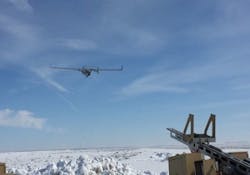Verizon acquires UAS tech company, UAS wide-area imaging tests, unmanned systems competition
Check out this week’s article from the Association for Unmanned Vehicle Systems International (AUVSI), which takes a look at some of the latest news and headlines in unmanned vehicles and robotics, including Verizon’s acquisition of Skyward, a company specializing in drone operations management, as well as headlines involving a UAS carrying a wide area sensor, and an unmanned systems competition.
Verizon acquires Skyward to streamline UAS operations management
In an effort to simplify UAS operations and management for organizations of all sizes, Verizon has announced that it has acquired Skyward, a company that not only specializes in drone operations management, but also has the technology to accomplish Verizon’s goals.
Using Skyward’s technology, Verizon will look to streamline the management of UAS operations through one platform built to handle a variety of end-to-end activities, including everything from mission planning to FAA compliance support.
Simplifying UAS operations and management will allow developers and businesses to generate and oversee a wide-range of services, which will all be supported by Verizon’s mobile private network, secure cloud interconnect and data analytics capabilities.
Mike Lanman, senior vice president of Enterprise Products and IoT at Verizon, says, "this acquisition is a natural progression of our core focus on operating in innovative, high-growth markets, leveraging our network, scale, fleet management, device management, data analytics and security enablement capabilities and services to simplify the drone industry and help support the adoption of IoT."
Jonathan Evans, Skyward’s founder and CEO, adds, "Skyward's drone operations management platform combined with Verizon's network, reliability, scale and expertise in delivering enterprise solutions will allow organizations to efficiently and safely scale drones across multiple divisions and hundreds of use cases."
Logos Technologies and Insitu conduct first flight of Integrator tactical UAS equipped with Redkite wide-area sensor
Logos Technologies and Insitu have announced that in early February, the two companies successfully conducted an initial flight test of the Integrator small tactical UAS, equipped with the Redkite wide-area sensor (pictured).s
The test, which was conducted in Boardman, OR, USA, was the first time that a wide-area motion imagery (WAMI) system has been transported on a small UAS through its internal payload bay.
"Integrator with Redkite will enable an even broader set of missions and keep our warfighters out of harm’s way," says Insitu’s chief technology officer Pete Kunz.
Weighing in at less than 30 pounds, the Redkite is capable of detecting, tracking and recording all significant movers within a city-sized area (over 12 square kilometers) that it is imaging. While the sensor is flying, multiple users on the ground can use desktop screens, tablets and other mobile devices to view real-time and/or historical video feeds from the sensor’s coverage area.
In total, up to 10 unique views can be transmitted by the Redkite to hundreds of users at one time. The Redkite also has the ability to store up to eight hours of geo-tagged mission data through its onboard solid state drives.
XPRIZE announces 21 teams advancing in semifinals of Shell Ocean Discovery XPRIZE competition for unmanned systems
XPRIZE, a non-profit organization that designs and manages public, incentive competitions aimed at finding innovative technologies that can help humanity, has announced the 21 teams that it has chosen to advance in the semifinals of the Shell Ocean Discovery XPRIZE competition, which will award a total of $7 million throughout the contest.
The three-year global competition, which started in December 2015, seeks to find unmanned and robotic technologies capable of handling tasks involving ocean exploration and discovery. Entries for the competition include gliders, drones, underwater robotic swarms, AUVs, robotics, artificial intelligence and massive computing platforms.
The 21 teams picked represent 13 different countries, including the United States, which makes up more than half of the field with 11 teams, as well as countries such as China, France and Ghana. The teams come from a variety of backgrounds, including undergraduate and graduate universities, non-profits, startups, and professional scientists and engineers.
"These semifinalist teams are on the cutting-edge, pushing the boundaries in developing deep-sea underwater technologies that will work in the lightless, cold depths to fully map one of our world’s final frontiers like never before," says Jyotika Virmani, the prize lead and senior director with XPRIZE’s Energy and Environment Group.
"Through the Ocean Discovery XPRIZE, we have an unprecedented opportunity to create next generation tools, technologies and techniques that will illuminate deep-sea wonders and unlock a new era of ocean exploration."
View more information on the AUVSI.
Share your vision-related news by contacting James Carroll, Senior Web Editor, Vision Systems Design
To receive news like this in your inbox, click here.
Join our LinkedIn group | Like us on Facebook | Follow us on Twitter
Learn more: search the Vision Systems Design Buyer's Guide for companies, new products, press releases, and videos

